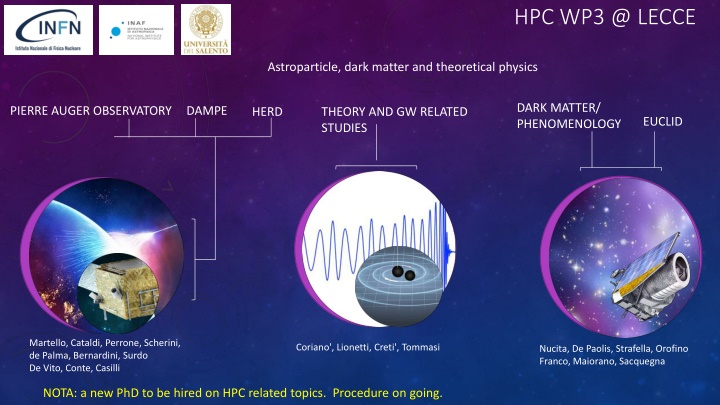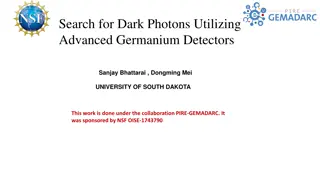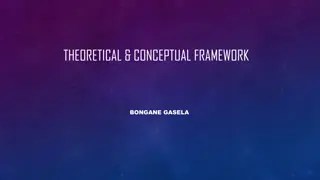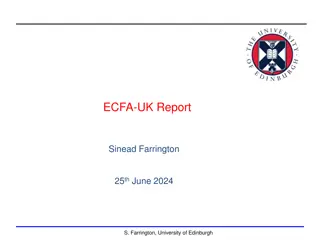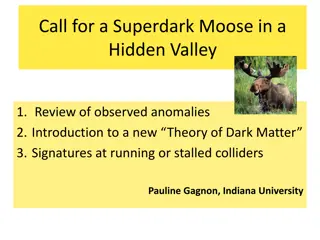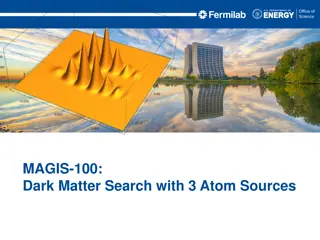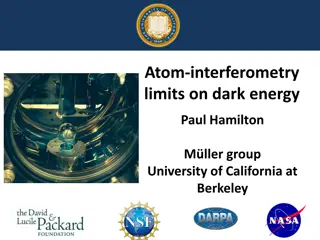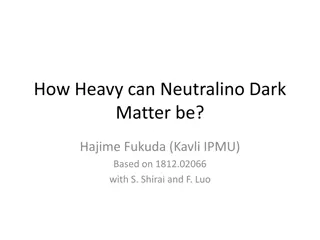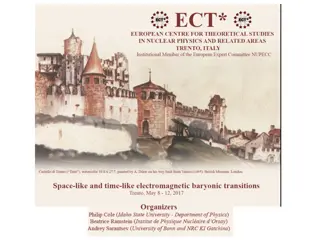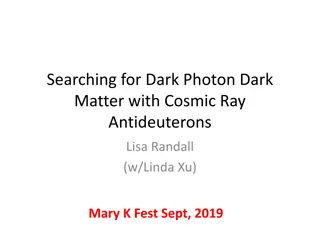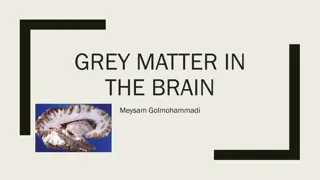Astroparticle, Dark Matter, and Theoretical Physics Studies
Astroparticle and dark matter research at the Pierre Auger Observatory, DAMPE, and HERD with a focus on theoretical physics, computational simulations, and machine learning applications for data analysis and event reconstruction. Explore the analysis of upward-going events, the search for exotic particles, and the upcoming HERD facility. Stay updated with the latest findings and collaborations in the field.
Download Presentation

Please find below an Image/Link to download the presentation.
The content on the website is provided AS IS for your information and personal use only. It may not be sold, licensed, or shared on other websites without obtaining consent from the author.If you encounter any issues during the download, it is possible that the publisher has removed the file from their server.
You are allowed to download the files provided on this website for personal or commercial use, subject to the condition that they are used lawfully. All files are the property of their respective owners.
The content on the website is provided AS IS for your information and personal use only. It may not be sold, licensed, or shared on other websites without obtaining consent from the author.
E N D
Presentation Transcript
HPC WP3 @ LECCE Astroparticle, dark matter and theoretical physics DARK MATTER/ PHENOMENOLOGY PIERRE AUGER OBSERVATORY DAMPE HERD THEORY AND GW RELATED STUDIES EUCLID Martello, Cataldi, Perrone, Scherini, de Palma, Bernardini, Surdo De Vito, Conte, Casilli Coriano', Lionetti, Creti', Tommasi Nucita, De Paolis, Strafella, Orofino Franco, Maiorano, Sacquegna NOTA: a new PhD to be hired on HPC related topics. Procedure on going.
Analysis of the upward-going events interacting with the fluorescent detector of the Pierre Auger Observatory. The signals are potentially realated to neutrinos or more xotic particles not predicted by the standard model From a very preliminar analysis it is found that an accurate background estimate is required in order to get a correct interpretation of the data and to get a reliable confidence of the results. Computational times are large since there is the necessity to simulate extended and inclined showers and to simulate the response of the detector in realistic conditions. A "Real Monte Carlo Simulation approach is required. HERD PIERRE AUGER OBSERVATORY DAMPE Computational time of 8 months of CPU time. The performance could be enlarged using dedicated algorithms of Machine Learning to be applied to the analysis of the traces.This would help in disentangle the candidate events from the background Open Data In a multi messenger approach, one possible synergy among the groups is the creation of a common platform in order to share, store and compare the data coming from different experiments a l https://opendata.auger.org References a) Search for upward-going showers with the fluorescence detectors of the Pierre Auger Observatory PoS(ICRC2021)1140 b) The exposure of the hybrid detector of the Pierre Auger Observatory Astropart. Phys. 34 (2011) 368-3 c) Deep-Learning based Reconstruction of the Shower Maximum Xmax using the Water-Cherenkov Detectors of the Pierre Auger Observatory The Pierre Auger Collaboration, JINST 16 (2021) P07019 d) Extraction of the Muon Signals Recorded by the Surface Detector of the Pierre Auger Observatory Using Recurrent Neural Networks The Pierre Auger Collaboration, JINST 16 (2021) P07016 e) The 2021 Open-Data release by the Pierre Auger Collaboration PoS(ICRC2021)1386 https://opendata.auger.org/
DAMPE is now a 7 years old mission. For the analysis of the acquired data intensive Monte Carlo simulation is required in order to get good confidences of the results.. Machine Learning are applied to discriminate CRs and to reconstruct the traces and calibrate the instruments. HERD a new coming space facility to be in operation in 2027. To develope the instruments intensive Monte Carlo simulations are required to estimate the efficiency of detection. Machine learning and AI applications are planned to reconstruct the events and disentangle the nature of the incoming particle. HERD PIERRE AUGER OBSERVATORY DAMPE References J. Chang et al. "The DArk Matter Particle Explorer mission", Astroparticle Physics 95} (2017) 6-24 DAMPE Collaboration (G. Ambrosi et al.) "Direct detection of a break in the teraelectronvolt cosmic-ray spectrum of electrons and positrons", Nature 552 (2017) 63 G. Ambrosi et al. "The on-orbit calibration of DArk Matter Particle Explorer", Astroparticle Physics 106 (2019) 18-34 G. Ambrosi et al. (DAMPE Collaboration) "Measurement of the cosmic-ray proton spectrum from 40 GeV to 100 TeV with the DAMPE satellite", Science Advances 5 (2019) eaax3793 F. Alemanno et al. (DAMPE Collaboration) "Measurement of the cosmic ray helium energy spectrum from 70 GeV to 80 TeV with the DAMPE space mission", Physical Review Letters 126 (2021) 201102 M. Stolpovskiy et al. "Machine learning-based method of calorimeter saturation correction for helium flux analysis with DAMPE experiment on behalf of the DAMPE collaboration", Journal of Instrumentation, Volume 17, June 2022 D. Kyratzis and on behalf of the HERD "Collaboration Overview of the HERD space mission Physica Scripta, Volume 97, Number 5,2022
Gravitational wave interactions in modified models of gravity with quadratic (Gauss Bonnet) gravity. Interaction with the Virgo group in Rome (Ref. Pia Astone and Cristiano Palomba) for modeling and simulations of signal detection in binary pulsars at large separations Numerical simulations of gravitational wave (GW) production in strongly first order phase transitions Numerical studies of GW emission in models of modified gravity with scalar degrees of freedom from topological corrections. Numerical simulations of the propagation of electromagnetic waves in presence of axion condensates and with dark photons due to a kinetic mixing. NOTE: a new RTDa to be hired (on HPC funds) to work on these issues. Procedure on-going. THEORY AND GW RELATED STUDIES Methodology Development of codes for the identification of signals in models of modified gravity Collaborative data analysis. Study and optimization of existing codes. References Dimensional regularization of topological terms in dilaton gravity. Coriano et al., POS2022, e-print 2205.03535 Einstein Gauss-Bonnet theories as ordinary Wess-Zumino conformal anomaly action, Coriano et al., 2022, Phys. Lett. B, 828, 137020 Conformal field theory in momentum space and anomaly actions in gravity: the analysis on three and four-point functions, Coriano et al., 2022, PHYS. REPT, 952, 1-95 Dark matter with light and ultralight Stuckelberg Axions, Coriano et al., 2020, POS2020, e-print: 2005-02292 Dark Matter with Stuckelberg Axions, Coriano et al., 2019, Front.in Phys., 7, 36 Neutrino and photon lensing by black holes: radiative lens equations and newtonian contributions, Coriano et al., 2015, JHEP, 07, 160. Dark matter as Ultralight axion-liken particle in E6xU(1)X GUT with QCD Axion, Coriano et al., 2017, Phys.Lett.B, 782, 380 Conformal unification in a quiver theory and gravitational waves, Coriano et al., 2020, Phys. Lett.B, 811, 1359909
EUCLID/LEGACY SCIENCE At present: performing simulations of deep field images to be delivered to various teams. Expected computational time of 1-2 months CPU times. Developing algorithms for source searching: LSB (low surface brightness galaxy), GCs (Globular Clusters), UDGs (Ultra compact Galaxies) Machine Learning and AI (convolutional neural networks) for the classification and characterization of sources. DARK MATTER/ FENOMENOLOGIA Management of SS transient legacy science: Developing detection to search for transients on catalogues (Necessity of parallelized code on CPUs? necessity of GPUs? New algorithms?). EUCLID References Detecting Solar System Objects with convolutional neural networks Lieu et al., 2019, MNRAS, 486, 5831L
